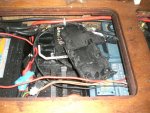Strolls
Well-Known Member
So am I right in understanding that if a battery in your house bank drops a cell, you only really have two choices:Id go with this answer - once one battery drops a cell for whatever reason if not noticed fairly early on you can pretty much guarantee it will kill the other battery as well - it's good practice to change both batteries at the same time or you will continually have one old battery "killing" the new one after a fairly short period of time.
- Replace the whole house bank.
- Remove the dead battery and accept you now have a smaller reserve of battery power.
Sorry to ask a dumb noob question, but I just wanted to be completely clear.

